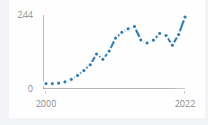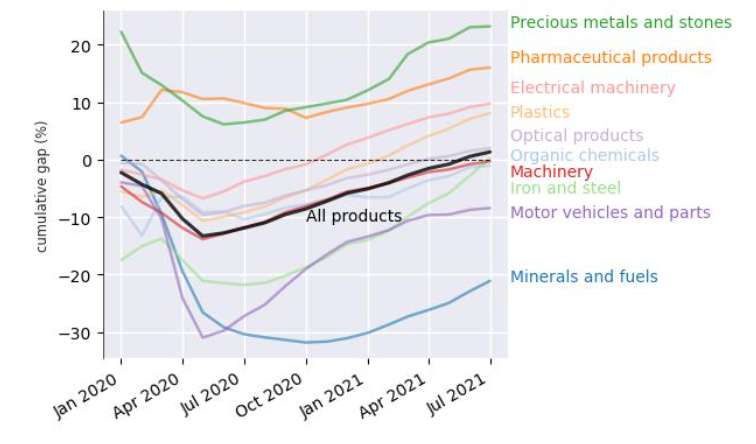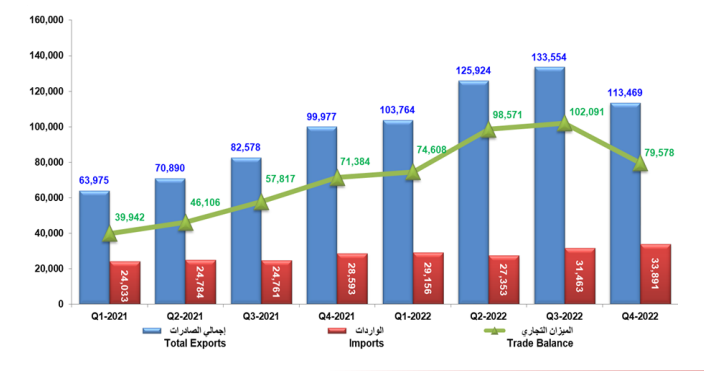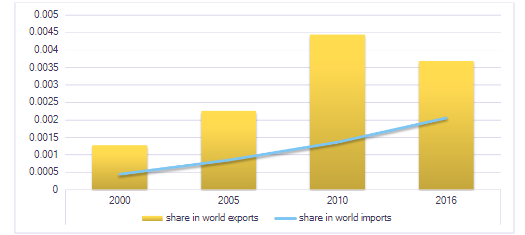Unlocking Qatar's Global Trade Dynamics: A Comprehensive Analysis
Question
Task: How has Qatar strategically leveraged its natural gas reserves to become a major player in international trade, and what factors contribute to its success in both exports and imports?
Answer
Introduction
International trade according to Samue, (2019) is an activity of selling and purchasing products and services beyond regional borders. In most cases, international trade is encouraged by firms and national governments that have the potential to conduct business on an international scale. Every nation across the world is involved in international trade so as Qatar where different nations are connected in different ways. Qatar’s trade and its related policies are essentially focused on developing a liberal and modern economy. In the year 2021, trade contributed about 93% of the national GDP as per the report developed by the World Bank (Lloyds Bank, 2023). The report will analyse the case of Qatar and its international trade and different countries associated with it and the reason behind the association. The discussion has been supported by theories hence it has offered insightful knowledge to the readers.
Overview of Qatar’s trade activity and its significance
The Qatar Ministry of Commerce and Industry called for the formulation of a free trade zone in 2018, to propagate the formation of an Islamic Common Market. Though this did not benefit the country during globalisation, it helped Qatar maintain its position in the global economic act. At present, the trade policy of Qatar is dedicated to creating a modern and liberal economy (Parveen, 2020). Qatar in trading with other nations pose a significant strategy and growth in their business to get the resources that are required for their business in a budget friendly price and develop healthy trade relationship with different nations. Qatar imports major resources that are required in business like foods, technologies materials etc. which are required in the nation for growth and development. Furthermore, it provides great economic welfare which contributes to global efficiency. When a nation opens for trade it brings various opportunities that are beneficial for their growth and bring progress in the nation in every possible area. The trade activity of Qatar is significant for their growth as they possess a dry climate where the lands are not suitable for agriculture and are costly. Therefore, trading with other nations helps to get the resources and their requirements at a reasonable price and this also helps them to maintain a healthy relationship with other countries.
Compared to the other countries that are a part of the Gulf Cooperation Council (GCC), it has relatively low trade restrictions. This is due to its free trade agreements with the GCC, which also helped it form trade relations with Pakistan. Most of its profits have been resources from the production and export of oil, liquefied gas and condensates. The country also deals with the oil and gas sector, which brings profit due to the hike in the price of hydrocarbons. Trade represented almost 93% of the country's GDP in 2021, which has helped to hike it significantly over time (World Bank, 2022).

Figure 1: Growth in Qatar’s GDP, Source: (World Bank, 2022).
Qatar has been known for its export of mineral fuels, oils and distillation products. It has also imported several manufacturing products, machinery, electrical equipment and vehicles other than the railway. The trading partners of Qatar in 2019 included the US, China, Germany, Britain, India, Turkey and Oman. As for the trade partners in terms of exports, Japan and South Korea have been major destinations for the country in 2019. During the first half of 2020, the exports to Japan, China, South Korea and Singapore, remained consistent (Planning and Statistics Authority of Qatar, 2020).
.png)
Foreign trade of Qatar by originators and destination (2019).
Source: (Planning and Statistics Authority of Qatar, 2020).
Foreign trade was significantly impacted by the advent of the COVID-19 pandemic. Studies state that most countries of the Middle East had significantly low production of materials at this stage. The supply of minerals and slues, which had been the major source of income, had been significantly impacted by the pandemic. In recent years, it has also been affected by trade wars between China and the US, as both countries are essential parts of its international trading system. The effect of the recent Ukrainian war has also affected the surplus production in recent years.

Figure 3: Global trade value during 2020-2021
Source: (Organisation for Economic Co-operation and Development, 2021).
In 2020 the value of Qatar's total exports including the export of goods and re-exports, amounted to 113.5 million. This increased by 13.5 % when compared to the reports from 2021. This increase in exports was due to the higher exports of mineral fuels, lubricants and related minerals. The export of chemicals and related products has also seen an increase of 0.3%, followed by manufacturing materials at 5.0%. Imports of the country have been increased by 18.5% compared to the imports in 2021. The increase in the import value has been, mainly caused by the increase in import of manufactured articles, food and live animals, manufactured goods classified as materials, machinery and transport equipment. There has also been a decrease in the import of crude materials, inedible and fuels by 11.2%.

Figure 4: Export, Import and Merchandise Trade Report of 2022
Source: (Planning and Statistics Authority (PSA), 2022).
The major export partners of 2022 were predominantly of the Asian subcontinent, which consists of 66.1% to 36.4% of all the exports from Qatar. They were followed by the European Union accounting for 24.05 and 25.9% respectively, and finally GCC with 6.3%. The reports regarding the trading activities of Qatar in 2023 are yet to be disclosed by the Qatar government.
The reason behind Qatar’s product export success

Figure 5: Main export partners of Qatar
Source: (Lloyds Bank, 2023).
It is evident in the above figure that Qatar has 10 major countries regarding the export of its national products where China stands in first position. Qatar is known mainly for exporting 60% liquefied natural gas, and 30% crude oil in different nations. It has been found that the major countries Qatar is associated with in terms of export activity have not been bound by a trading penalty and traffic by the United Arab Emirates and Saudi Arabia. Therefore, it has become easier for Qatar to be associated with these countries on a large scale. Qatar has the world's 3rd largest established natural gas reserve because of which the nation can export natural gas in 2nd largest position. Its extensive reserve of natural gas can also be considered as one of the main reasons behind its export success.

Figure 6: Qatar’s contribution in world export
Source: (Chemingui and Eris, 2019).
From the above figure, it can be observed that there has been an increasing graph about the export activity of Qatar's export rate in a global manner. Before the existence of the petrol-based sector, Qatar was not considered as a strong economy also it used to have a smaller economy. However, the emergence of the oil and gas sector in 1939 provided an opportunity for the nation to boost its economy. There was a significant growth in production and revenue which shifted Qatar from the poorest nation to the highest per capita income contributor across the world. Also, the major countries that Qatar is associated with such as China, India, Japan, South Korea etc have a potential market to explore which has been taken efficiently by Qatar. For example, it has been displayed in the below figure that the majority of liquefied natural gas that India imports is majorly dependent on Qatar. It provides Qatar with an opportunity to have a high supplier power as stated in Porter's five forces model.

Figure 7: Distribution of import of liquefied natural gas in India
Source: (Statista Research Department, 2023).
Few international markets rely majorly on Qatar's export activity provides an opportunity for Qatar to gain a cost advantage. Comparative advantage theory emphasises that a nation should focus on products that comprise comparative advantage (Seretis and Tsaliki, 2015). This is because it has a major advantage in the international market where free and equal exchange among involved countries can be encouraged. It has been found that international trade mainly favours nations with comparative advantage. Therefore, from the case of Qatar, one can assume that it has a comparative advantage since the nation can produce specific products at a very limited cost compared to its trading partners. There are nations such as India, China etc., which can initiate for low-cost approach in product development however they do not have the raw materials source that Qatar has. Hence, it can be Qatar has used the opportunity of its available natural resources and has developed a trading relationship with nations that lack those natural resources, which is the main reason behind its success. Among available natural resources some of the major exported oil and gas have been demonstrated in the below figure.

The reason behind Qatar importing the products it imports
Qatar is one of the significant nations and is known for its technology fastest emerging nation in the world. The resources and materials that are imported into Qatar are manufactured goods, machinery and transport equipment, food and live animals which are one of the major imports of the country.
From the figure it has been identified that the total imported goods in Qatar in 2022 was approximately 33.2 million USD (O’Neill, 2022). The country significantly depends on imports of their foods and necessary resources for their living. The country imports nearly 40 per cent of its food from Saudi Arabia which gets in through land transportation mode (BBC, 2017).
Heckscher Ohlin Theory
The theory states the equilibrium between two or more trade nations based on their varying specialities and resources. The theory states how a country has to operate when resources are imbalanced between two nations and in a global region. The theory states that the distribution of income in a nation also describes the demand for commodities. Demands for commodities determine the required production and supply of the products which is one of the significant parts of international trade (Pal, 2018). One of the main reasons for imports of the products is because of the dry climate where most of the lands are not suitable for agriculture and farming and it also costs high to produce crops. Moreover, it has also been identified that the local food industry does not have adequate knowledge, expertise and infrastructure to produce foods at a cheaper rate than the foods they import from other nations (Irani, 2017). Qatar supplies most of its products from Saudi Arabia because of its small land and the increase in demand for the products and resources in the nation. Furthermore, lack of expertise and experience in agriculture and other areas the country imports its products and other resources from other nations.
The main reason behind Qatar's trading with different countries
One of the main reasons for Qatar to trade with other countries is to develop internal trade relations in the global region. Qatar trades oils and other natural resources with many countries and imports machinery and food resources which are a significant part of living. The country fully integrates into international free trade and economic system and reflects significant and committed relations with other countries and world trade organisations. Furthermore, the country is distinguished for having a good baking sector and no restrictions to transferring huge capital abroad by making it a free trade zone (Ministry of Foreign Affairs, 2022). The country has shown a positive growth in international trade relations and has brought a significant impact on its economy. Moreover, the country is more focused on diversifying its economy in the international region which is one of the main reasons for its trade with countries. The economy of Qatar is based on petroleum and natural gas and is focused on creating a sustainable and resilient economy by lessening its dependency on the oil and gas industry and developing new sectors and industries (Olusegun, 2023). Qatar imports most of its food products from Saudi Arabia and they both share healthy relations and have shown a positive relationship in terms of trade. It has also been identified that the borders are open for both nations to travel which symbolises a healthy and free relationship. Moreover, Qatar and Bahrain after some disputes are working on developing a relationship between the two nations. Moreover, Qatar is looking for a free trade agreement with China with a deal to sell natural gas for around 28.8 billion USD and an increase in China helps to harvest solar energy which is beneficial for business use. China and the Council of Qatar have held free trade deal in their ten-round talks including its in-depth discussion of services, investment, goods and customs procedures (Jennings, 2023). The main reason for trading with China is to gain technology and their solar power energy which can be used in the desert of Qatar to generate power making it a sustainable energy and developing healthy trade relations between the two nations.
Conclusion
Qatar is considered one of the wealthiest nations in the world as it is rich in natural gas and oil but it has to import most of its products like foods, machinery and other resources which are important for their living. The country imports food as it major product for the people and is because of the dry climate where land is not suitable for agriculture and farming. The country shares a healthy relationship with international borders to increase its economy, and trade relations and diversify its economy for their growth and development. For binging continuous growth and development, it is important for Qatar to trade with other nations which allows them to get the resources at an adorable price. Qatar trades with numerous countries like Saudi Arabia, China, Greece etc. where they look to export natural gas and oils and import the resources in agreed agreement between the nations and develop a fair and healthy relationship for long-term trade.
References
BBC (2017). Qatar crisis: What you need to know. BBC News. [online] 19 Jul. Available at: https://www.bbc.com/news/world-middle-east-40173757 [Accessed 18 Oct. 2023].
Chemingui, M. and Eris, M. (2019).TRADE PERFORMANCE AND STRUCTURE PROFILES 1 Qatar. [online] ResearchGate. Available at: https://www.researchgate.net/publication/332979800_TRADE_PERFORMANCE_AND_STRUCTURE_PROFILES_1_Qatar?_tp=eyJjb250ZXh0Ijp7ImZpcnN0UGFnZSI6InB1YmxpY2F0aW9uIiwicGFnZSI6Il9kaXJlY3QifX0 [Accessed 18 Oct. 2023].
Irani, Z. (2017). Qatar blockade is a warning to all desert countries that rely on imported food. [online] The Conversation. Available at: https://theconversation.com/qatar-blockade-is-a-warning-to-all-desert-countries-that-rely-on-imported-food-80283 [Accessed 18 Oct. 2023].
Jennings, R. (2023). Qatar has high hopes for China-Persian Gulf trade deal as Beijing eyes energy. [online] South China Morning Post. Available at: https://www.scmp.com/economy/china-economy/article/3237028/china-seeks-supercharge-energy-deals-middle-east-qatar-eyes-benefits-free-trade-agreement [Accessed 20 Oct. 2023].
Lloyds Bank (2023). Foreign trade figures of Qatar - International Trade Portal. [online] www.lloydsbanktrade.com. Available at: https://www.lloydsbanktrade.com/en/market-potential/qatar/trade-profile#:~:text=In%202021%2C%20the%20main%20trading [Accessed 18 Oct. 2023].
Ministry of Foreign Affairs (2022).Trade. [online] mofa.gov.qa. Available at: https://mofa.gov.qa/en/qatar/economy-today/trade#:~:text=Qatar%20fully%20integrates%20into%20the [Accessed 18 Oct. 2023]. O’Neill, A. (2022). Qatar - Import of goods 2022. [online] Statista. Available at: https://www.statista.com/statistics/380010/import-of-goods-to-qatar/#:~:text=The%20statistic%20shows%20the%20value [Accessed 18 Oct. 2023].
OEC (2020). What does export? (2021) | OEC. [online] OEC - The Observatory of Economic Complexity. Available at: https://oec.world/en/visualize/tree_map/hs92/export/qat/all/show/2021/ [Accessed 20 Oct. 2023].
Olusegun, A. (2023). ‘Entrepreneurship to drive Qatar’s diversification goals’. [online] thepeninsulaqatar.com. Available at: https://thepeninsulaqatar.com/article/15/05/2023/entrepreneurship-to-drive-qatars-diversification-goals#:~:text=%E2%80%9CQatar [Accessed 18 Oct. 2023].
Organisation for Economic Co-operation and Development (2021).OECD. [online] read.oecd-ilibrary.org. Available at: https://read.oecd-ilibrary.org/view/?ref=1129_1129345-casormobh7&title=International-trade-during-the-COVID-19-pandemic.
Pal, R. (2018).(PDF) Heckscher-Ohlin and Other Theories. [online] ResearchGate. Available at: https://www.researchgate.net/publication/323388547_Heckscher-Ohlin_and_Other_Theories [Accessed 18 Oct. 2023].
Parveen, T. (2020). Trade and Foreign Investment—Keys to Diversification in Qatar . [online] researchgate.net. Available at: https://www.researchgate.net/publication/346015122_Trade_and_Foreign_Investment-Keys_to_Diversification_in_Qatar [Accessed 18 Oct. 2023].
Planning and Statistics Authority (PSA) (2022).Press Release on Quarterly Foreign Merchandise Trade Statistics 2022. [online] Available at: https://www.psa.gov.qa/en/statistics/Statistical%20Releases/Economic/ForeignTrade/2022/Q4/FT_PR_Q4_2022_AE.pdf [Accessed 18 Oct. 2023].
Samue, A. (2019). (PDF) International Trade and Its Impact on the Global Economy. [online] ResearchGate. Available at: https://www.researchgate.net/publication/335703233_International_Trade_and_Its_Impact_on_the_Global_Economy [Accessed 18 Oct. 2023].
Seretis, S. and Tsaliki , P.V. (2015). (PDF) Absolute Advantage and International Trade: Evidence from Four Euro-zone Economies. [online] ResearchGate. Available at: https://www.researchgate.net/publication/282349783_Absolute_Advantage_and_International_Trade_Evidence_from_Four_Euro-zone_Economies [Accessed 18 Oct. 2023].
Statista Research Department (2023).India: LNG import share by country 2021. [online] Statista. Available at: https://www.statista.com/statistics/1237488/lng-import-share-india-by-country/#:~:text=India [Accessed 18 Oct. 2023].
World Bank (2022).Qatar | Data. [online] Worldbank.org. Available at: https://data.worldbank.org/country/qatar [Accessed 18 Oct. 2023].












